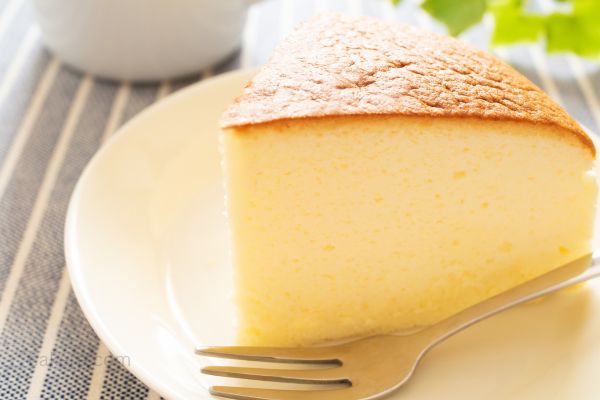Japanese fluffy cake, also known as Japanese cotton cake or Japanese soufflé cake, has been gaining popularity worldwide for its unique and delightful taste. This airy, light, and fluffy confectionery has captured the hearts and taste buds of people all around the globe.

The Origins of Japanese Fluffy Cake
The roots of Japanese fluffy cake trace back to the post-war era in Japan. As the country embraced Western influences, traditional sponge cakes were transformed into the lighter, airier version we now know and love.
The technique to achieve this unique texture was perfected over time, and today, it stands as a symbol of Japanese culinary ingenuity.
The Ingredients That Make It Special
The secret to the extraordinary taste and texture of Japanese fluffy cake lies in its simple yet carefully selected ingredients.
High-Quality Eggs
The key to achieving the signature fluffiness is the use of high-quality eggs. Fresh eggs with high protein content create a stable and voluminous foam during the whisking process.
Fine Flour
The use of fine cake flour ensures a smooth and tender crumb in the cake, contributing to its soft texture.
Sugar and Milk
Sugar and milk play a crucial role in adding sweetness and moisture to the cake, providing a delicate and balanced flavor.
Neutral Oil
Neutral oil, such as vegetable or canola oil, keeps the cake moist and light, without adding any distinctive flavors.
Cream of Tartar
Cream of tartar is a leavening agent that stabilizes the egg whites and helps the cake rise evenly.
The Baking Technique: A Balancing Act
The baking process for Japanese fluffy cake requires precision and finesse. The batter is gently folded to maintain the airiness, and it is baked using a water bath to prevent excessive browning.
The Taste Profile of Japanese Fluffy Cake
Fluffiness Beyond Compare
Japanese fluffy cake’s texture is its hallmark feature. It’s incredibly light, airy, and almost melts in your mouth with every bite.
Delicate Sweetness
The cake’s sweetness is subtle, allowing the other flavors to shine through without overwhelming the palate.
Subtle Creaminess
The presence of milk in the batter gives the cake a soft and creamy touch, adding to its luxurious taste.
A Hint of Vanilla
A touch of vanilla extract elevates the cake’s flavor, providing a delightful and comforting aroma.
How to Enjoy Japanese Fluffy Cake
Japanese fluffy cake is best enjoyed fresh, on its own, or with simple accompaniments that complement its delicate flavors.
Pairing Possibilities
Fresh Fruits and Whipped Cream
Serve the cake with a medley of fresh, seasonal fruits and a dollop of lightly sweetened whipped cream for a delightful and refreshing experience.
Japanese Green Tea
Pair the cake with a cup of traditional Japanese green tea to savor the subtle interplay of flavors between the cake and the tea.
Citrus Sorbet
For a zesty twist, serve the cake with a citrus sorbet, enhancing its lightness with a burst of tangy goodness.
Decadent Chocolate Sauce
Indulge in the luxurious combination of Japanese fluffy cake and rich, velvety chocolate sauce for a dessert fit for royalty.
Japanese Fluffy Cake: A Global Phenomenon
The delectable allure of Japanese fluffy cake has transcended borders and has become a global phenomenon.
Bakeries and patisseries around the world are now serving this delightful treat to cake enthusiasts everywhere.
Baking Your Own Japanese Fluffy Cake: Tips and Tricks
For those inspired to embark on a baking adventure, follow these tips to ensure the perfect Japanese fluffy cake every time:
Precise Measurements
Measure the ingredients carefully to maintain the delicate balance required for the cake’s fluffy texture.
The Right Mixing Technique
Gently fold the batter to preserve the airiness and prevent deflation.
Patience Is Key
Baking Japanese fluffy cake requires patience, as it takes time to achieve the perfect texture.
Proper Cooling and Storage
Allow the cake to cool thoroughly before storing it to retain its softness and moisture.
FAQs
Japanese fluffy cake differs from regular sponge cake in its texture and ingredients. The use of high-quality eggs and a special baking technique gives it a light and airy texture, unlike the denser texture of a traditional sponge cake.
While it is essential to follow the recipe for the best results, minor substitutions can be made. However, keep in mind that ingredient swaps may affect the final texture and flavor of the cake.
Typically, Japanese fluffy cake contains wheat flour and is not gluten-free. However, some variations may use alternative flours for those with gluten sensitivity.
Japanese fluffy cake is best enjoyed fresh, but you can bake it a few hours in advance. Store it in an airtight container to maintain its softness.
Conclusion
Japanese fluffy cake is a delightful masterpiece that combines a cloud-like texture with a subtle sweetness and creamy undertones.
It has captured the hearts of people worldwide and continues to bring joy to dessert lovers.
Whether you savor it on its own or explore creative pairings, this ethereal confection is sure to leave a lasting impression.
